London (North & East)
THE EAST END
In the nineteenth century, East London was the home of the poor, living in overcrowded narrow alleys and eking out a precarious living by menial labour in the docks and factories. Today, the efforts of the Luftwaffe and post-war slum clearance have transformed the landscape, so that whole street plans have disappeared under new housing blocks, although elegant Georgian terraces survive in some places. The area is now multiracial and multicultural and while the stark poverty of the past has gone, it still struggles to rid itself of the label of "inner-city deprivation".
Because of its traditional image, the East End has often attracted the efforts of zealous and energetic Christians to heed the prophet's call to preach the good news to the poor. Two men from the Victorian period stand out - William Booth, founder of the Salvation Army, and Thomas Barnado, whose work with destitute children grew into Dr Barnado's Homes.
WHITECHAPEL - The Salvation Army
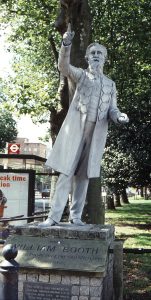
William Booth statue
Few men in any sphere could match the extraordinary vision and energy of William Booth (1829-1912). Born in Nottingham to a family that had fallen on hard times, he was already flirting with Chartism when he was converted at the age of fifteen. His first employment, in a pawnbroker's shop, brought him face-to-face with the harsh realities of poverty. Booth trained as a Methodist preacher, but eventually his zeal and powerful oratory demanded a wider sphere of opportunity.
In 1865, Booth began a preaching mission, not far from the present Blind Beggar pub in Whitechapel Road. Initially just called the Christian Mission, the work was reorganized on military lines and became the Salvation Army in 1878. Capitalizing on the popularity of military uniforms and brass bands, he took the gospel into the heart of the slums, introducing a host of initiatives for welfare and reform which anticipated the social legislation of the twentieth century. Vagrants, drunkards and prostitutes were all within his vision and many underwent remarkable conversions.
In the early days, Booth and his growing army made use of any available premises; pubs, theatres, markets and even a dancing academy were all employed for preaching and welfare work. Many of the original buildings have gone but there are still memories of the early days of the Army. At the point where the Whitechapel Road becomes the Mile End Road is a bronze bust of Booth on the north side, close to the White Hart pub. Some fifty yards beyond is a full statue, erected in 1979 to celebrate the 150th anniversary of his birth. Both show the General in braided Army uniform with the motto Blood and Fire on his chest.

Prof Orson's Dancing Academy
During the early days, Booth was preaching in a tent pitched on the site of a disused Quaker burial ground in Vallance Road. Recently, the site was re-landscaped as a recreational space and there is a memorial sundial recalling Booth's connection. When the tent blew down in a gale, Booth transferred to Professor Orson's Dancing Academy at 23 New Road, just off Commercial Road (E1 2AX). The building still stands, now divided into flats. A blue plaque tells us that the first indoor meetings of the future Salvation Army were held here on 3rd September 1865. Close by, at 102 Christian Street is the site of the first building to be used for the Army's welfare work. A young girl living at a notorious brothel was brought here in 1881, the first of many to be rescued from lives of shame and degradation. The original building has gone and the site is now the premises of a knitwear company.
On the corner of Fieldgate Street and Greenfield Street is a clothing factory which stands on the site of the Ebenezer Hall. This was the Army's first permanent meeting place and from 1880 the War Cry was printed and distributed from here. Reflecting the religious mix of the present East End, the site is immediately behind the East London Mosque and also close to a small Jewish synagogue.
STEPNEY - Dr Barnado's Homes
Contemporary with Booth, but called to a different ministry was Thomas Barnado (1845-1905). Barnado came from Dublin to train as a doctor at the London Hospital, intending to go to China as a missionary. What he saw of the condition of homeless children transformed his life.
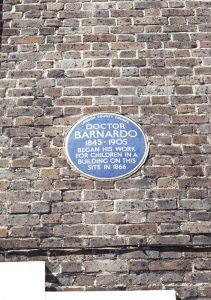
Hope Place, Stepney
In 1866, he hired a donkey shed in Hope Place, Stepney, for use as a "ragged school". One evening he challenged a small boy who wanted to stay the night. The lad, called Jim Jarvis, showed him places where dozens of other homeless children huddled together for warmth at night. Barnado rented two houses close by and took in twenty-five boys. He described his work as the East End Juvenile Mission, but it soon became universally known as Dr Barnado's Homes. By the time of Barnado's death in 1905, there were more than eight thousand children living in his homes, and eighteen thousand had found new lives in Canada and Australia.
Hope Place no longer exists, but the site in Ben Jonson Road is marked by a blue plaque on the wall of 58 Solent House (E1 3NL). Today it is in the heart of London's Bengali community. When Barnado published his first East End Juvenile Mission report in 1868, he was living at 47 Barnes Street, near York Square, not far from Hope Place. Today it is an attractive end-of-terrace private house in an area which has survived bombs and redevelopment.

Barnado memorial, Stepney Causeway
In 1870, a boys' home was opened in Stepney Causeway, off Commercial Road (E1 0JM), which bore the famous slogan No destitute child ever refused admission. This was adopted after Barnado was distraught to find that a boy he had casually turned away one night because he had no space had died later of hypothermia. At one time, various Barnado establishments lined both sides of the Causeway as far as the railway bridge. Barnado's closed their offices here in 1968 and the buildings were demolished to extend the Pitsea housing estate. A bronze plaque on Ogilvie House, on the east side, records that Dr Barnado's first home for boys stood on this site 1870-1970. The name of an adjacent street was changed from Ann Street to Barnado Street in 1911.
The Edinburgh Castle gin palace and music hall used to stand in Rhodeswell Street, on the site of the present Mile End Stadium car park, not far from the original donkey sheds in Hope Place. In 1872, its takings had been severely reduced by Barnado's preaching and he bought the place and used it as a Working Men's Club selling tea, coffee and cocoa. Many of the poor came to find warmth and refreshment that they could ill afford at home. Later a church and mission hall were also built here.

Ragged School Museum, Stepney
None of these buildings has survived but close by is a permanent reminder of Barnado's work. The Ragged School Museum in Copperfield Street (E3 4RR) is a former warehouse, complete with iron hoists on the front, built in 1872 alongside the Regent's Park Canal. It was used by Barnado's as a school from 1877 to 1909 and saved from demolition in the 1980s. Today it serves as a focus for community activities and has a friendly atmosphere. The ground floor has a general display reflecting social changes in Whitechapel, Stepney and Bethnal Green, the area now known by the clumsy collective name of Tower Hamlets. The first floor is laid out as a Victorian schoolroom with wooden desks and blackboard, while the top floor has a replica of a typical nineteenth century East End kitchen.
An unusual white-painted house with a mock classical frontage at 12 Dock Street, Wapping, was opened by Barnado in 1888 as the Free Lodging House for young women in the wake of the "Jack the Ripper" murders.
BOW
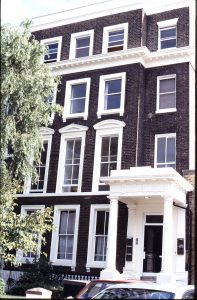
Dr Barnado's house, Bow Road
Two houses actually lived in by Thomas Barnado still exist. In Coburn Street off Bow Road, a plaque on No 30 says that this was his first lodging in London. According to local historian Tom Ridge, the actual house was three doors away at No 33; No 30 served for a time as the headquarters of the China Inland Mission. Both are handsome three-storey Georgian houses, described as "paired villas". Not far away is 32 Bow Road, where Barnado and his wife lived from 1875 to 1879 (E3 4LN). It is an elegant four-storey end-of-terrace house, which was later used as a training home for girls entering domestic service. 182 Grove Road, Hackney was known as the Children's Fold and was used by Barnado's as a home for disabled children from 1888 to 1911.
ISLINGTON
The church of St Mary's in Upper Street has a long record of evangelical ministry and continues to be active in the community. For a few months in 1738, Charles Wesley was curate to the vicar George Stonehouse, but opposition from the churchwardens forced his resignation. The wardens also excluded George Whitefield from the pulpit, so his first experience of open-air preaching was in the churchyard here in April 1739. An early picture of Whitefield preaching, lost when his tabernacle in Tottenham Court Road was destroyed during World War II, showed him outside St Mary's.
In 1824, Daniel Wilson (1778-1858) became vicar and, despite initial opposition, laid the foundation of a vigorous and effective urban ministry, a model for other churches. He mapped out the parish into districts and enrolled house-to-house visitors. Nine Sunday Schools were founded and at his first confirmation he presented the bishop with 780 candidates. In 1832, he left to become Bishop of Calcutta.
The church was rebuilt in the twentieth century with a sculpted nativity scene above the classical portico, but retaining the original tower and spire. The churchyard which once echoed to the fervent preaching of Whitefield has been landscaped into a peaceful garden.
STOKE NEWINGTON

Isaac Watts monument
Abney Park Cemetery is a theme park to Victorian funereal art. Apart from the main paths, the whole site has been allowed to revert to its natural state as an urban nature reserve. Between the trees and bushes obelisks, urns and angels peer out at drunken angles, ivy-covered tombs and headstones lie abandoned, and at the centre is a derelict chapel complete with tall spire. Depending on temperament, some will find the atmosphere romantic and evocative, others eerie and oppressive.
The cemetery occupies the site of Abney House and Park, once the residence of Sir Thomas Abney and his wife, who also owned Theobalds at Cheshunt in Hertfordshire. In 1712, the nonconformist preacher and hymn writer Isaac Watts (1674-1748) came to stay for some rest and recuperation after a bout of ill-health, and remained until his death thirty-six years later! Sir Thomas was clearly a man given to hospitality, but history doesn't relate whether he felt his guest had outstayed his welcome. Watts served as an unofficial domestic chaplain, preaching at either of the houses as his health allowed, while continuing to write poems, hymns and pamphlets. Watts is buried in Bunhill Fields, but his statue on a plinth near the centre commemorates his association with Abney Park. A quote from one of Watts' own hymns provides an appropriate epitaph Ages unborn shall make his songs the joy and labour of their tongues.
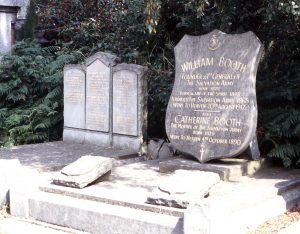
William Booth's grave
At the southern end of the cemetery, close to the entrance in Newington Church Street, is an area devoted to the pioneers of the Salvation Army. On 29th August 1912, William Booth, the founder and first General, was laid to rest here following a funeral procession through the streets of London, witnessed by immense crowds. Like the man himself, the gold-lettered inscription on his tomb is plain and uncompromising: Born 1829, born again of the Spirit 1845, founded the Salvation Army 1865, went to heaven 20th August 1912. He lies next to his beloved wife and co-worker Catherine, Mother of the Salvation Army, born 1829, went to heaven 4th October 1890. Close by are the graves of two of Booth's earliest collaborators, George Scott Railton and converted prizefighter Elijah Cadnam. Opposite lie Booth's son and second General, William Bramwell Booth (1856-1929), this time using the more familiar Army terminology promoted to glory, and other members of the Booth family.
Stoke Newington has two St Mary's churches, facing each other across Newington Church Street. St Mary's Old Church has the date 1563 over the door but its foundations go back much further. The larger new church was built in 1858 to serve the growing population of the area. The puritan Thomas Manton (1620-1677) was rector of the Old Church from 1645 to 1656 and is buried in the chancel.
TOTTENHAM HIGH CROSS
A blue plaque on the wall of an estate agent at 316 Tottenham High Road records that John Williams (1796-1839) missionary and shipbuilder was born nearby.
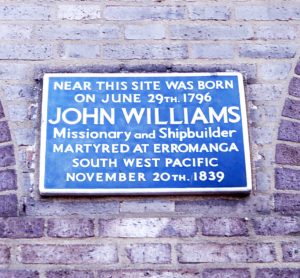
John Williams birthplace
Following the voyages of Captain Cook, missionary societies began to turn their attention to the difficult, and often dangerous, task of evangelism in the South Pacific. Williams was converted at Moorfields Tabernacle in 1814 and commissioned for service with the London Missionary Society at the Surrey Chapel on 29th September 1816; sharing the service with him was another pioneer, Robert Moffatt, who became the father-in-law of David Livingstone.
Establishing himself on the island of Raiatea, Williams built a chapel and schoolhouse, translated and printed parts of the Bible and introduced the cultivation of sugar cane. Travel between the islands was always a problem. On one occasion, finding himself marooned on Rarotonga with no iron tools, Williams with incredible ingenuity built himself a 60-foot boat that he named Messenger of Peace. In 1839 he met his end on the island of Erromanga, clubbed to death by natives who had been ill-treated by European sailors. Williams' achievements and his ultimate sacrifice aroused interest in the region, and a succession of vessels named after him were built and used in missionary work among the South Pacific islands well into the twentieth century.
BARKINGSIDE
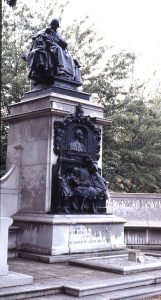
Barnado memorial
In 1876, Thomas Barnado opened his village home for girls at Barkingside, then well out in the Essex countryside and away from the stench and dirt of London. The site, in Tanner's Lane (IG6 1QG), is the present headquarters of the Barnado's charity, providing office space for its various enterprises. It can be visited by permission. The semi-detached cottages where the girls used to live are grouped around a village green, and the community had its own church, which still stands.
When Barnado died in 1905, his ashes were interred here and a handsome memorial erected, in the form of a semicircular stone seat, with a bronze profile of the good doctor. The statue on top shows a lady with two infants on her lap, while below are three girls, clearly thriving in their new rural environment.
BARKING
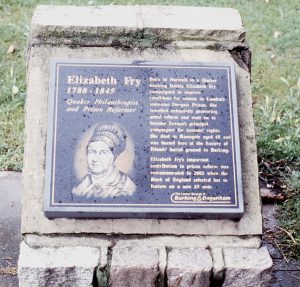
Elizabeth Fry memorial
Opposite the Sikh temple in North Street is an area of scrubby grass, enclosed by hedges and crossed by asphalt footpaths (IG11 8JD). A sign asks us to treat the site with respect as this is the former Quaker Burial Ground. There are no headstones, but recently a small plinth has been erected to remind us that one who lies here is the great philanthropist and prison reformer Elizabeth Fry (1780-1845). Her appearance on £5 banknotes brought her work and achievements to wider public attention.
MILL HILL
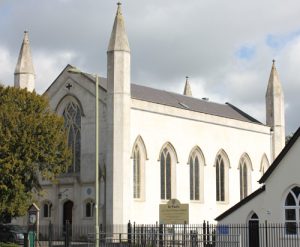
St Paul's, Mill Hill
After retiring from Parliament in 1825, slave trade abolitionist William Wilberforce (1759-1833) bought the estate of Hendon Park, where his immediate neighbour was Sir Stamford Raffles, founder of Singapore and the London Zoo. The house no longer stands, but the site is marked by a blue plaque beside the road on the north side of Highwood Hill, close to the junction with Clarks Lane. For a time the estate was managed by Wilberforce's eldest son, also called William, but his lack of business acumen lead to heavy financial losses and forced its sale
While living here, Wilberforce promoted and paid for the building of St Paul's Church on The Ridgeway (NW7 1QU). This soaring white-painted building, with pinnacles at each corner, has recently undergone a major restoration.


